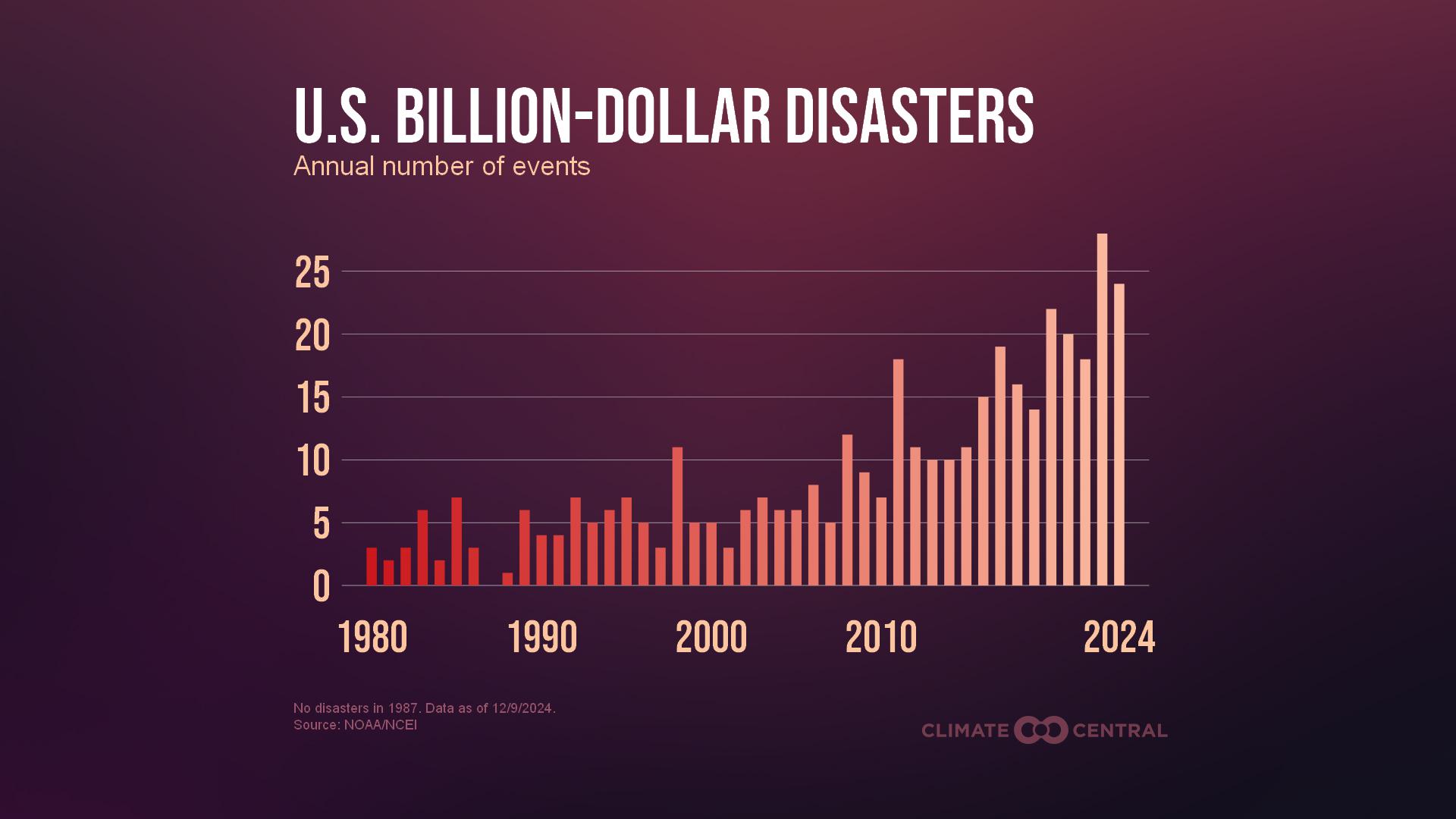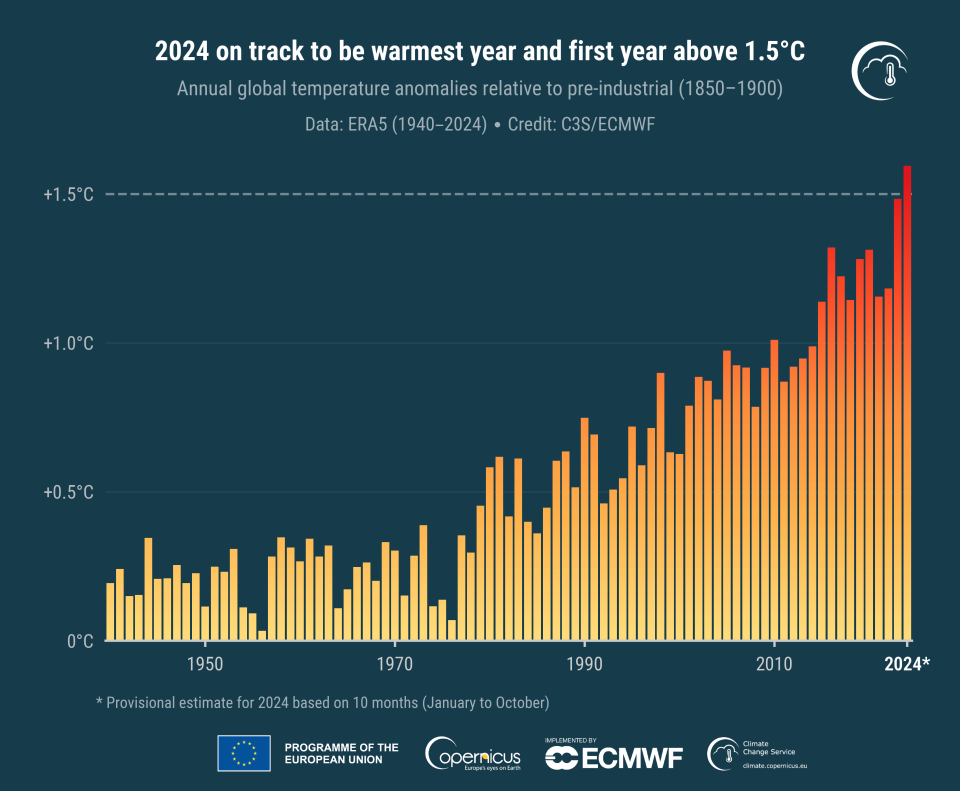By Jim Bloch
“2023 was the hottest year on record, and 2024 is on track to be even hotter — and the first year when the average temperature will top 1.5°Celsius warmer than the pre-industrial average.”
That’s the assessment of Climate Central, the nonprofit organization that studies climate change and its impact on the modern world, in its report “2024 in Review,” released Dec. 12.

1.5 degrees C is 2.7 degrees Fahrenheit. The number is significant inasmuch as it was temperature goal set by the Paris Climate Accord in 2015, beyond which the consequences of climate change would essentially become ungovernable and include intensifying heat waves, droughts, hurricanes, tornadoes, hail and rainstorms, melting ice caps, rising sea levels, and a host of other calamities. The Paris goal, however, was not for a single year, but rather a decades-long target. Technically, the Earth remains below that long-term threshold.
By the end of November, 2024 stood at 2.77 degrees Fahrenheit above the average established in the early days of the industrial revolution, 1881-1919.
2023 was 1.48 degrees Celsius above the preindustrial level, according to Copernicus, the Earth observation arm of the European Union’s space program.
The global average temperature in 2023 was 14.98 degrees C – or 58.964 degrees F; 2023 overtook 2016 as the hottest year on record.

2023 and 2024 experienced more billion dollar weather disasters than any other two-year period in U.S. history.
The National Oceanic and Atmospheric Administration will release its climate data for the calendar year 2024 on Jan. 10, 2025.
Two dozen billion dollar disasters
The U.S. in 2024 saw 24 weather and climate disasters that exceeded $1 billion in damages, the most of any year ever except 2023, when there were 28.
“These 24 billion-dollar disasters have resulted in an estimated 418 deaths and $61 billion in damages,” said Climate Central in its release. “However, these (January – November) totals do not include damages associated with Hurricanes Helene or Milton, which may add a stark $100 billion or more to this figure. If so, the 2024 total damages would surpass the $95 billion combined disaster costs in 2023.”
2024 hurricanes included Hurricane Beryl in July; in August, Hurricane Debby; in September, Hurricane Helene; in October, Hurricane Milton. The last three were marked by rapid intensification during which the storms increased in velocity by more than 35 miles an hour in less than 24 hours, raising havoc with meteorologists and giving residents little time to prepare or evacuate.
Seventeen of the billion dollar storms were thunder storms strong enough to spin off tornadoes, winds of 58 mph or higher and/or barrages of hail.
Less time between disasters
There are more big-dollar weather and climate disasters than ever – and they are getting closer together.
In the 1980s, there were 82 days on average between billion dollar disasters. By 2023, the recovery time between these events had dropped to 15 days. From January-November 2024, the interval had declined to 12 days.
Wildfire weather
As of Dec. 13, the Franklin fire in Malibu, California has expanded to 4,000 acres and was 30 percent contained. More than 12,500 people live in the area ordered by fire officials to evacuate.
“Fire weather seasons in the U.S. have grown longer and more intense since the 1970s — particularly in western states, where hotter temperatures exacerbate drought conditions that make wildfires easier to spread,” said Climate Central. “Carbon pollution released by wildfires creates a hazardous feedback loop by further contributing to climate warming.”
Winter storms
Since late November, the Midwest and Northeast have been plagued by brutal cold and massive lake effect snowstorms. Climate change is warming the Great Lakes, which then become a giant snow-making machine when temperatures plunge and strong cold winds out of the Arctic pour over the warm water.
“Emerging research suggests that climate change effects to the polar vortex are making conditions more favorable to these arctic cold snaps, though this is still an active area of research,” according to Climate Central.
Hope?
Humankind’s addiction to burning fossil fuels ends up spewing carbon dioxide and other gases into the atmosphere, trapping the heat from sun and warming the planet.
Each fraction of a degree of warming makes weather disasters worse and more likely.
“Well-established science shows that if we commit to rapid and sustained cuts in heat-trapping carbon pollution, we could set younger generations on a path toward a far safer future with reduced climate warming and fewer risky extreme events,” concluded the report.
Jim Bloch is a freelance writer based in St. Clair, Michigan. Contact him at bloch.jim@gmail.com.



